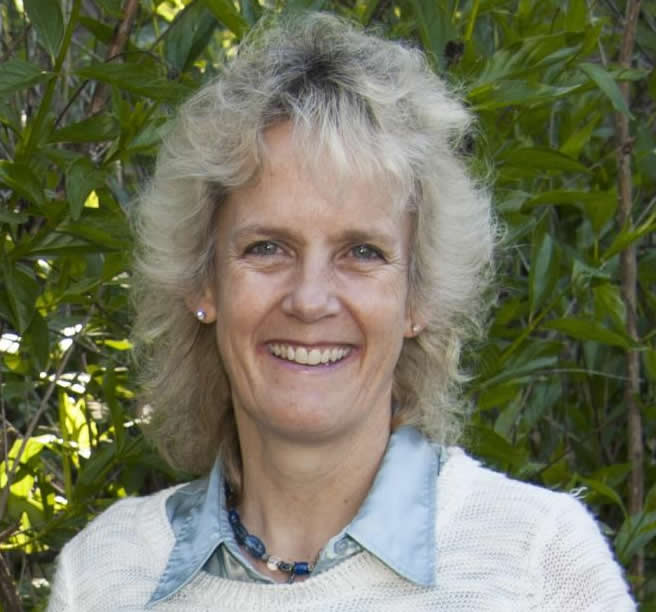
Bull Market - Collaboration with beef industry tests advanced breeding technologies
By Robin DeRieux
COWS ARE SPECIAL. As ruminants, they eat grass and other plants that are inedible to people, transforming forage into steak and hamburgers and other tasty high-protein beef products.

Over the past few decades, the beef industry has made significant improvements in productivity—generating more food from fewer numbers of cattle. Better breeding and other innovations in animal science research have played a starring role in these advances.
“More efficient cattle that produce higher yield per head reduce the overall environmental footprint of a pound of beef,” said Alison Van Eenennaam, a UC Davis Cooperative Extension specialist in animal genomics and biotechnology. “That’s why beef production efficiency matters to the general public.”
As an expert in livestock genetics, Van Eenennaam wanted to try out advanced breeding technologies on a larger scale than the 150 head of cattle managed by the Department of Animal Science would allow. She sought an industry collaboration to do a research project involving genetic evaluations on a commercial herd to identify important traits such as fertility, growth and disease resistance.
Overcoming barriers
There were obstacles. One was the structure of the beef industry itself. In vertically integrated beef operations, one company owns the cows, the calves, the feedlot and the processing facility. More frequently in the beef industry, however, the cow-calf sector sells to the feedlot, where cattle spend time fattening up for market before they are sold to the processing sector. There might be three or more different owners of an animal before your hamburger is served up next to your fries, and all these owners have different genetic selection objectives.
Separations in the supply chain make data sharing difficult and complicate breeding decisions. There are three primary sectors:
- Cow-calf sector, where owners are primarily interested in fertility, health and weaning weight
- Feedlot sector, where owners are interested in feed efficiency (how much weight is gained per pound of feed), plus health and carcass characteristics
- Processing sector, where carcass yield is paramount
“The people making the breeding decisions are way up at the cow-calf end of the supply chain,” said Van Eenennaam. “These circumstances make it difficult to implement the use of advanced breeding methods in the beef industry.”
Finding a commercial partner
Cattle in California is a $2.5 billion industry, one of the top 10 agricultural commodities in the state. In the United States, the cattle industry is the largest agricultural commodity in the nation, generating more than $100 billion in farm cash receipts.
Within the cattle industry, Van Eenennaam sought to partner with a vertically integrated company that could make the large initial investment required to get a genomic research operation up and running. Enter Simplot. She pitched a collaborative project to the livestock division of Simplot, a privately owned company based in Idaho, and together they launched a three-year research study with 14,000 cattle in 2014.
“This was a big, audacious, risky project at a time when genomic value had not been clearly demonstrated in the beef industry,” said Van Eenennaam. “It took a lot of trust and collaboration to get it done. But I think that’s exactly the role we should be playing, which is helping translate a new technology to industry.”
Tech industry helps too
From UC Davis, Van Eenennaam’s research team included master’s student Bryan Welly and postdoctoral fellow Justin Buchanan. Simplot’s participants included veterinarian Randall Raymond—director of research and veterinary services for Simplot Livestock—and a team of research technicians and data analysts, as well as feedlot and ranch staff. Also collaborating on the project was the biotechnology company GeneSeek, which provided genotyping services.
“Our goal was to really understand the economic costs and benefits of using a genomic selection system in a commercial beef cattle operation,” said Raymond of Simplot. “What we learned was that we can increase the accuracy of genetic selection, and we can increase the rate of genetic gain. But the cost of developing that system from scratch is very high, and there’s a long time frame to pay back the infrastructure costs.”
Although the three-year study at Simplot concluded in 2017, the UC Davis connection continues. The postdoctoral researcher who worked on the project with Van Eenennaam was subsequently hired as a geneticist by Simplot to continue the work.
“A lot of good research comes out of academia, but there’s not always a chance to apply it in industry,” said Buchanan, who joined Simplot in 2017. “A collaboration like this gives Simplot the opportunity to transfer that knowledge over to industry and to use it in a meaningful way.”
Faculty Contact
Alison Van Eenennaam, UC Davis Dept. of Animal Science, 530-902-0875, alvaneenennaam@ucdavis.edu
